Analyzing Key Influences and Transformations in Australian Healthcare
VerifiedAdded on 2021/06/18
|10
|2290
|92
Essay
AI Summary
This essay delves into the significant transformations within the Australian healthcare system, highlighting two primary influences: the Medicare program and the increasing emphasis on cultural awareness, particularly in the context of Indigenous healthcare. The paper explores how Medicare, a universal healthcare program, has improved access to medical services and the role of nurses in facilitating these changes. Furthermore, it examines the evolution of cultural safety in healthcare, emphasizing its importance in addressing the historical and ongoing health disparities faced by Aboriginal Australians. The essay underscores the significance of cultural sensitivity and understanding in delivering effective and equitable healthcare services. The role of nurses in adapting to healthcare policies and procedures is also considered. References include sources about Medicare, cultural safety, and nursing's role in healthcare transformation.
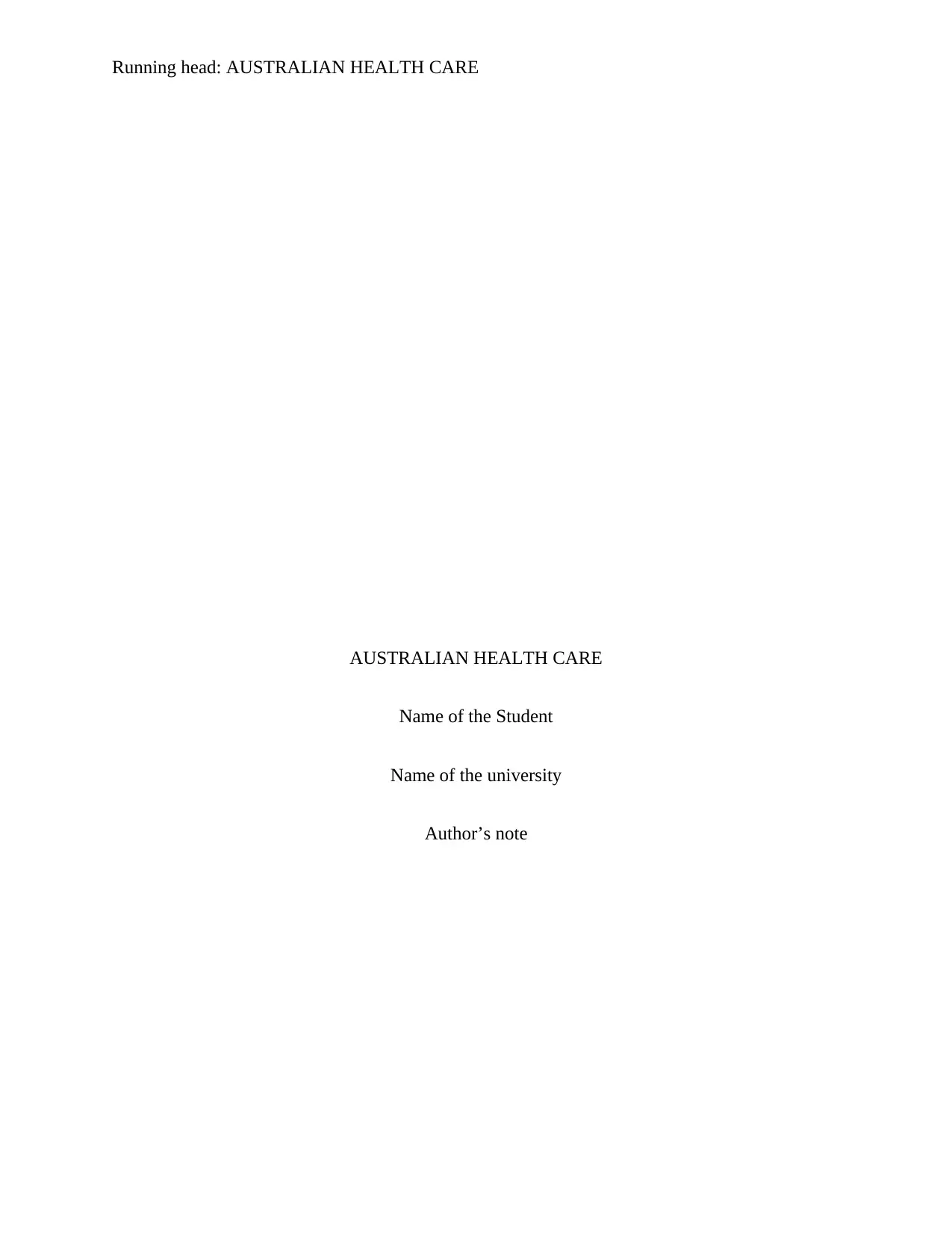
Running head: AUSTRALIAN HEALTH CARE
AUSTRALIAN HEALTH CARE
Name of the Student
Name of the university
Author’s note
AUSTRALIAN HEALTH CARE
Name of the Student
Name of the university
Author’s note
Paraphrase This Document
Need a fresh take? Get an instant paraphrase of this document with our AI Paraphraser
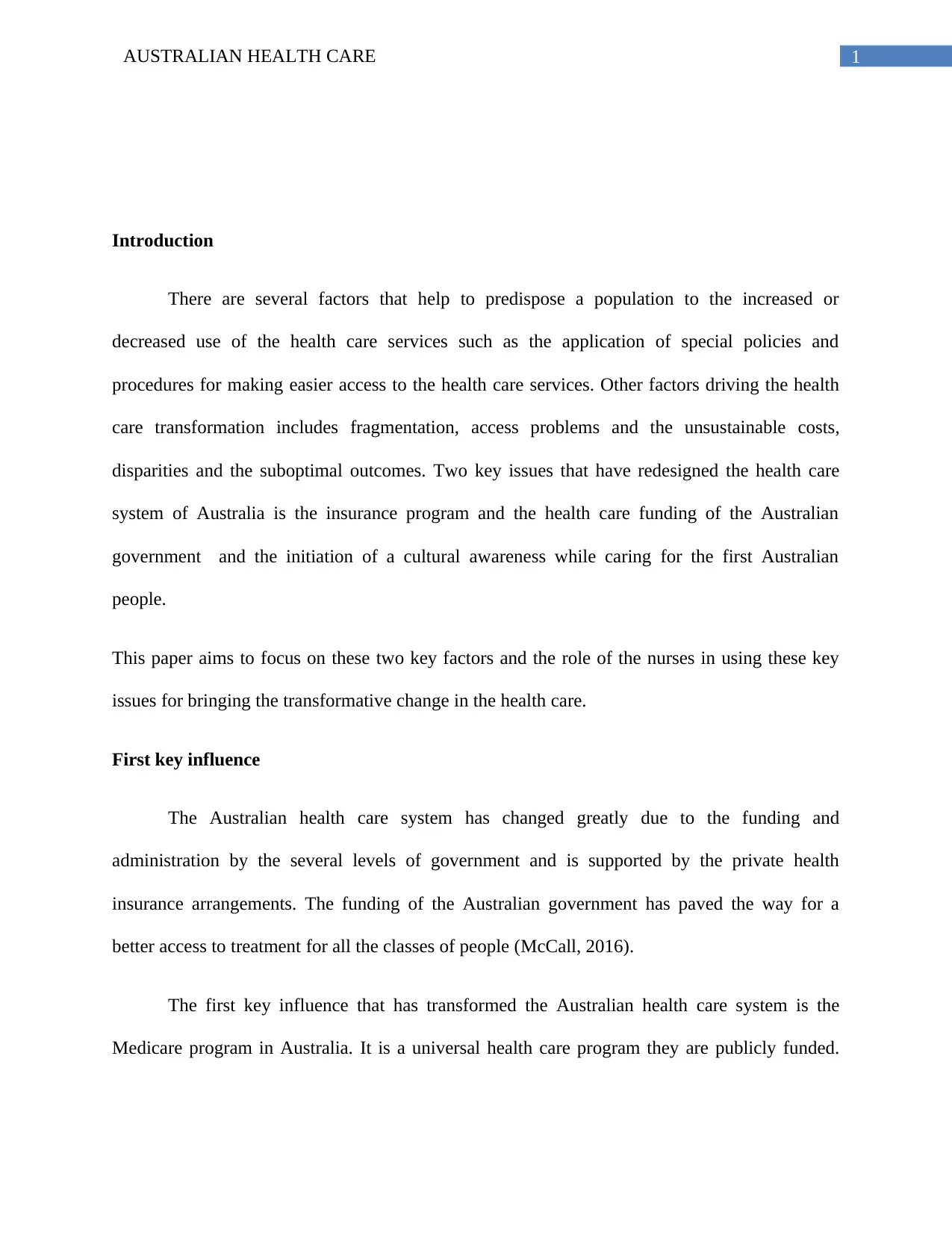
1AUSTRALIAN HEALTH CARE
Introduction
There are several factors that help to predispose a population to the increased or
decreased use of the health care services such as the application of special policies and
procedures for making easier access to the health care services. Other factors driving the health
care transformation includes fragmentation, access problems and the unsustainable costs,
disparities and the suboptimal outcomes. Two key issues that have redesigned the health care
system of Australia is the insurance program and the health care funding of the Australian
government and the initiation of a cultural awareness while caring for the first Australian
people.
This paper aims to focus on these two key factors and the role of the nurses in using these key
issues for bringing the transformative change in the health care.
First key influence
The Australian health care system has changed greatly due to the funding and
administration by the several levels of government and is supported by the private health
insurance arrangements. The funding of the Australian government has paved the way for a
better access to treatment for all the classes of people (McCall, 2016).
The first key influence that has transformed the Australian health care system is the
Medicare program in Australia. It is a universal health care program they are publicly funded.
Introduction
There are several factors that help to predispose a population to the increased or
decreased use of the health care services such as the application of special policies and
procedures for making easier access to the health care services. Other factors driving the health
care transformation includes fragmentation, access problems and the unsustainable costs,
disparities and the suboptimal outcomes. Two key issues that have redesigned the health care
system of Australia is the insurance program and the health care funding of the Australian
government and the initiation of a cultural awareness while caring for the first Australian
people.
This paper aims to focus on these two key factors and the role of the nurses in using these key
issues for bringing the transformative change in the health care.
First key influence
The Australian health care system has changed greatly due to the funding and
administration by the several levels of government and is supported by the private health
insurance arrangements. The funding of the Australian government has paved the way for a
better access to treatment for all the classes of people (McCall, 2016).
The first key influence that has transformed the Australian health care system is the
Medicare program in Australia. It is a universal health care program they are publicly funded.
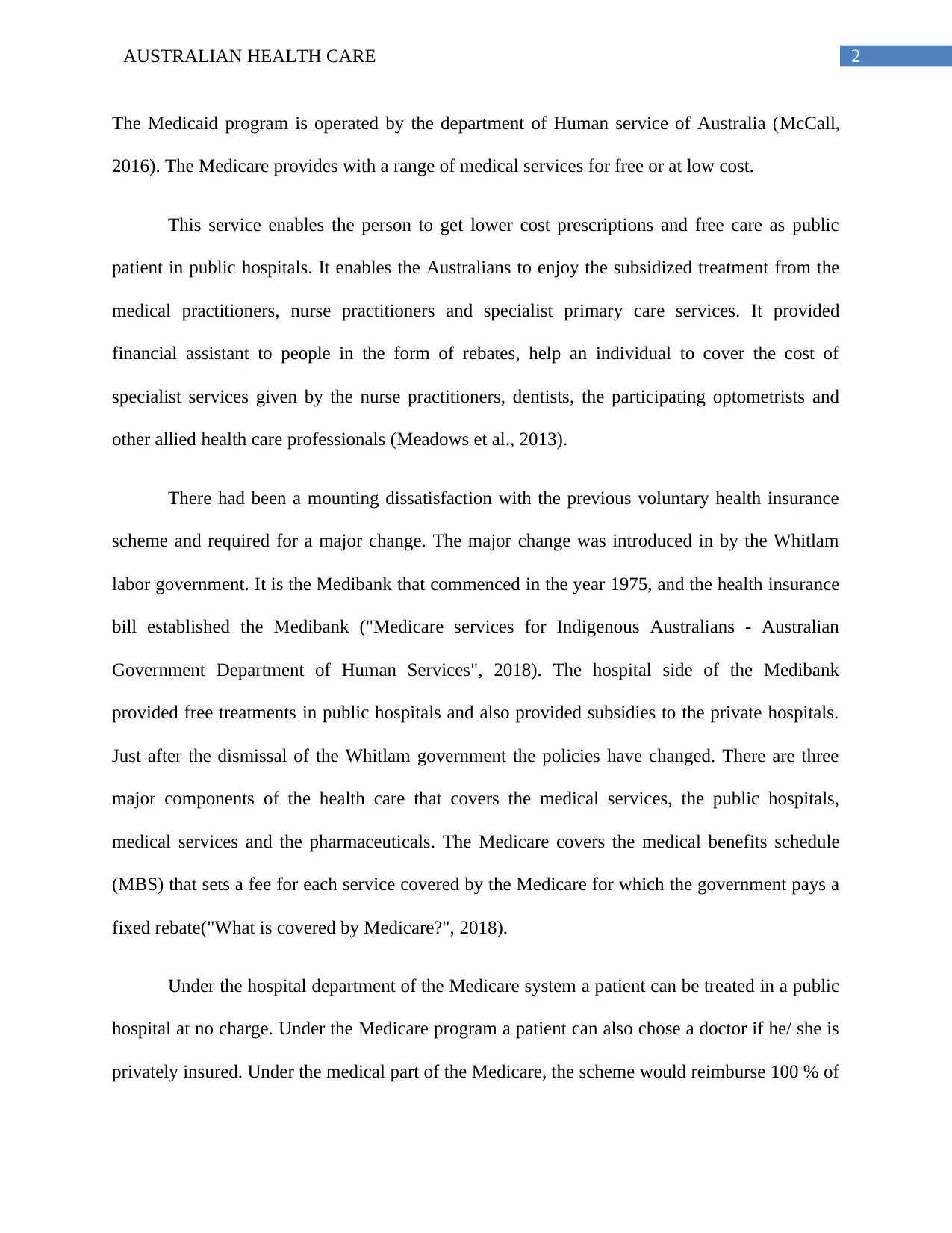
2AUSTRALIAN HEALTH CARE
The Medicaid program is operated by the department of Human service of Australia (McCall,
2016). The Medicare provides with a range of medical services for free or at low cost.
This service enables the person to get lower cost prescriptions and free care as public
patient in public hospitals. It enables the Australians to enjoy the subsidized treatment from the
medical practitioners, nurse practitioners and specialist primary care services. It provided
financial assistant to people in the form of rebates, help an individual to cover the cost of
specialist services given by the nurse practitioners, dentists, the participating optometrists and
other allied health care professionals (Meadows et al., 2013).
There had been a mounting dissatisfaction with the previous voluntary health insurance
scheme and required for a major change. The major change was introduced in by the Whitlam
labor government. It is the Medibank that commenced in the year 1975, and the health insurance
bill established the Medibank ("Medicare services for Indigenous Australians - Australian
Government Department of Human Services", 2018). The hospital side of the Medibank
provided free treatments in public hospitals and also provided subsidies to the private hospitals.
Just after the dismissal of the Whitlam government the policies have changed. There are three
major components of the health care that covers the medical services, the public hospitals,
medical services and the pharmaceuticals. The Medicare covers the medical benefits schedule
(MBS) that sets a fee for each service covered by the Medicare for which the government pays a
fixed rebate("What is covered by Medicare?", 2018).
Under the hospital department of the Medicare system a patient can be treated in a public
hospital at no charge. Under the Medicare program a patient can also chose a doctor if he/ she is
privately insured. Under the medical part of the Medicare, the scheme would reimburse 100 % of
The Medicaid program is operated by the department of Human service of Australia (McCall,
2016). The Medicare provides with a range of medical services for free or at low cost.
This service enables the person to get lower cost prescriptions and free care as public
patient in public hospitals. It enables the Australians to enjoy the subsidized treatment from the
medical practitioners, nurse practitioners and specialist primary care services. It provided
financial assistant to people in the form of rebates, help an individual to cover the cost of
specialist services given by the nurse practitioners, dentists, the participating optometrists and
other allied health care professionals (Meadows et al., 2013).
There had been a mounting dissatisfaction with the previous voluntary health insurance
scheme and required for a major change. The major change was introduced in by the Whitlam
labor government. It is the Medibank that commenced in the year 1975, and the health insurance
bill established the Medibank ("Medicare services for Indigenous Australians - Australian
Government Department of Human Services", 2018). The hospital side of the Medibank
provided free treatments in public hospitals and also provided subsidies to the private hospitals.
Just after the dismissal of the Whitlam government the policies have changed. There are three
major components of the health care that covers the medical services, the public hospitals,
medical services and the pharmaceuticals. The Medicare covers the medical benefits schedule
(MBS) that sets a fee for each service covered by the Medicare for which the government pays a
fixed rebate("What is covered by Medicare?", 2018).
Under the hospital department of the Medicare system a patient can be treated in a public
hospital at no charge. Under the Medicare program a patient can also chose a doctor if he/ she is
privately insured. Under the medical part of the Medicare, the scheme would reimburse 100 % of
⊘ This is a preview!⊘
Do you want full access?
Subscribe today to unlock all pages.

Trusted by 1+ million students worldwide
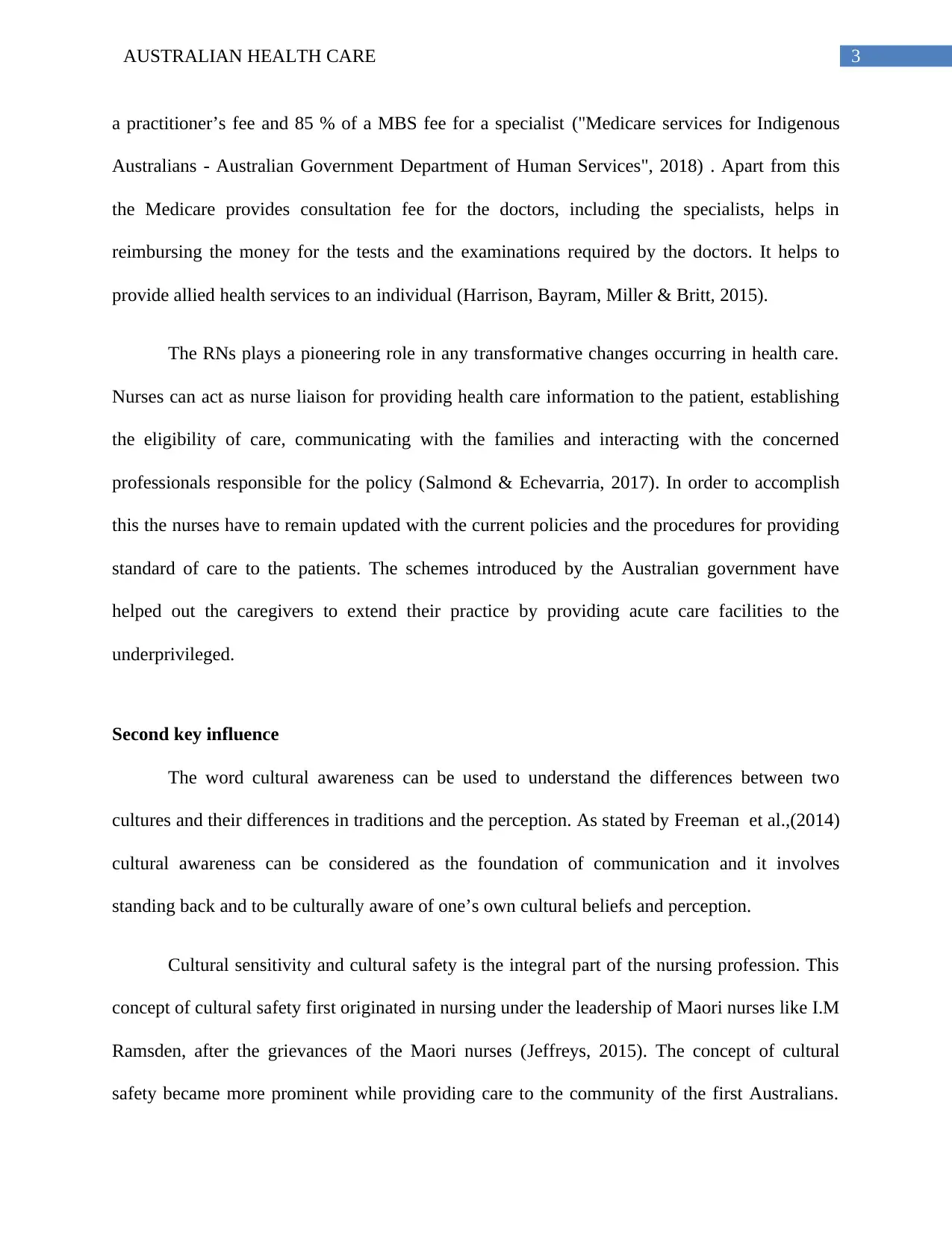
3AUSTRALIAN HEALTH CARE
a practitioner’s fee and 85 % of a MBS fee for a specialist ("Medicare services for Indigenous
Australians - Australian Government Department of Human Services", 2018) . Apart from this
the Medicare provides consultation fee for the doctors, including the specialists, helps in
reimbursing the money for the tests and the examinations required by the doctors. It helps to
provide allied health services to an individual (Harrison, Bayram, Miller & Britt, 2015).
The RNs plays a pioneering role in any transformative changes occurring in health care.
Nurses can act as nurse liaison for providing health care information to the patient, establishing
the eligibility of care, communicating with the families and interacting with the concerned
professionals responsible for the policy (Salmond & Echevarria, 2017). In order to accomplish
this the nurses have to remain updated with the current policies and the procedures for providing
standard of care to the patients. The schemes introduced by the Australian government have
helped out the caregivers to extend their practice by providing acute care facilities to the
underprivileged.
Second key influence
The word cultural awareness can be used to understand the differences between two
cultures and their differences in traditions and the perception. As stated by Freeman et al.,(2014)
cultural awareness can be considered as the foundation of communication and it involves
standing back and to be culturally aware of one’s own cultural beliefs and perception.
Cultural sensitivity and cultural safety is the integral part of the nursing profession. This
concept of cultural safety first originated in nursing under the leadership of Maori nurses like I.M
Ramsden, after the grievances of the Maori nurses (Jeffreys, 2015). The concept of cultural
safety became more prominent while providing care to the community of the first Australians.
a practitioner’s fee and 85 % of a MBS fee for a specialist ("Medicare services for Indigenous
Australians - Australian Government Department of Human Services", 2018) . Apart from this
the Medicare provides consultation fee for the doctors, including the specialists, helps in
reimbursing the money for the tests and the examinations required by the doctors. It helps to
provide allied health services to an individual (Harrison, Bayram, Miller & Britt, 2015).
The RNs plays a pioneering role in any transformative changes occurring in health care.
Nurses can act as nurse liaison for providing health care information to the patient, establishing
the eligibility of care, communicating with the families and interacting with the concerned
professionals responsible for the policy (Salmond & Echevarria, 2017). In order to accomplish
this the nurses have to remain updated with the current policies and the procedures for providing
standard of care to the patients. The schemes introduced by the Australian government have
helped out the caregivers to extend their practice by providing acute care facilities to the
underprivileged.
Second key influence
The word cultural awareness can be used to understand the differences between two
cultures and their differences in traditions and the perception. As stated by Freeman et al.,(2014)
cultural awareness can be considered as the foundation of communication and it involves
standing back and to be culturally aware of one’s own cultural beliefs and perception.
Cultural sensitivity and cultural safety is the integral part of the nursing profession. This
concept of cultural safety first originated in nursing under the leadership of Maori nurses like I.M
Ramsden, after the grievances of the Maori nurses (Jeffreys, 2015). The concept of cultural
safety became more prominent while providing care to the community of the first Australians.
Paraphrase This Document
Need a fresh take? Get an instant paraphrase of this document with our AI Paraphraser
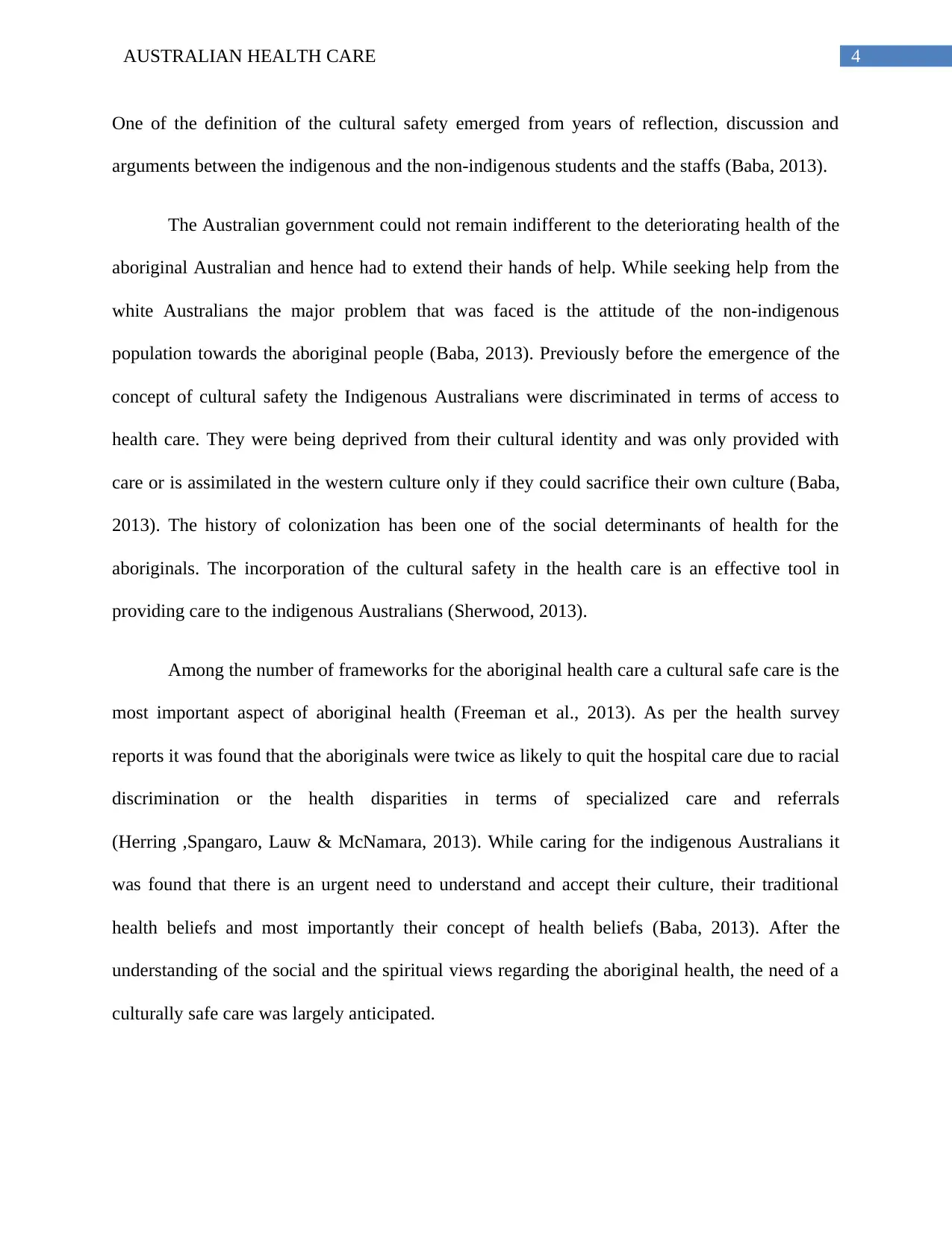
4AUSTRALIAN HEALTH CARE
One of the definition of the cultural safety emerged from years of reflection, discussion and
arguments between the indigenous and the non-indigenous students and the staffs (Baba, 2013).
The Australian government could not remain indifferent to the deteriorating health of the
aboriginal Australian and hence had to extend their hands of help. While seeking help from the
white Australians the major problem that was faced is the attitude of the non-indigenous
population towards the aboriginal people (Baba, 2013). Previously before the emergence of the
concept of cultural safety the Indigenous Australians were discriminated in terms of access to
health care. They were being deprived from their cultural identity and was only provided with
care or is assimilated in the western culture only if they could sacrifice their own culture (Baba,
2013). The history of colonization has been one of the social determinants of health for the
aboriginals. The incorporation of the cultural safety in the health care is an effective tool in
providing care to the indigenous Australians (Sherwood, 2013).
Among the number of frameworks for the aboriginal health care a cultural safe care is the
most important aspect of aboriginal health (Freeman et al., 2013). As per the health survey
reports it was found that the aboriginals were twice as likely to quit the hospital care due to racial
discrimination or the health disparities in terms of specialized care and referrals
(Herring ,Spangaro, Lauw & McNamara, 2013). While caring for the indigenous Australians it
was found that there is an urgent need to understand and accept their culture, their traditional
health beliefs and most importantly their concept of health beliefs (Baba, 2013). After the
understanding of the social and the spiritual views regarding the aboriginal health, the need of a
culturally safe care was largely anticipated.
One of the definition of the cultural safety emerged from years of reflection, discussion and
arguments between the indigenous and the non-indigenous students and the staffs (Baba, 2013).
The Australian government could not remain indifferent to the deteriorating health of the
aboriginal Australian and hence had to extend their hands of help. While seeking help from the
white Australians the major problem that was faced is the attitude of the non-indigenous
population towards the aboriginal people (Baba, 2013). Previously before the emergence of the
concept of cultural safety the Indigenous Australians were discriminated in terms of access to
health care. They were being deprived from their cultural identity and was only provided with
care or is assimilated in the western culture only if they could sacrifice their own culture (Baba,
2013). The history of colonization has been one of the social determinants of health for the
aboriginals. The incorporation of the cultural safety in the health care is an effective tool in
providing care to the indigenous Australians (Sherwood, 2013).
Among the number of frameworks for the aboriginal health care a cultural safe care is the
most important aspect of aboriginal health (Freeman et al., 2013). As per the health survey
reports it was found that the aboriginals were twice as likely to quit the hospital care due to racial
discrimination or the health disparities in terms of specialized care and referrals
(Herring ,Spangaro, Lauw & McNamara, 2013). While caring for the indigenous Australians it
was found that there is an urgent need to understand and accept their culture, their traditional
health beliefs and most importantly their concept of health beliefs (Baba, 2013). After the
understanding of the social and the spiritual views regarding the aboriginal health, the need of a
culturally safe care was largely anticipated.
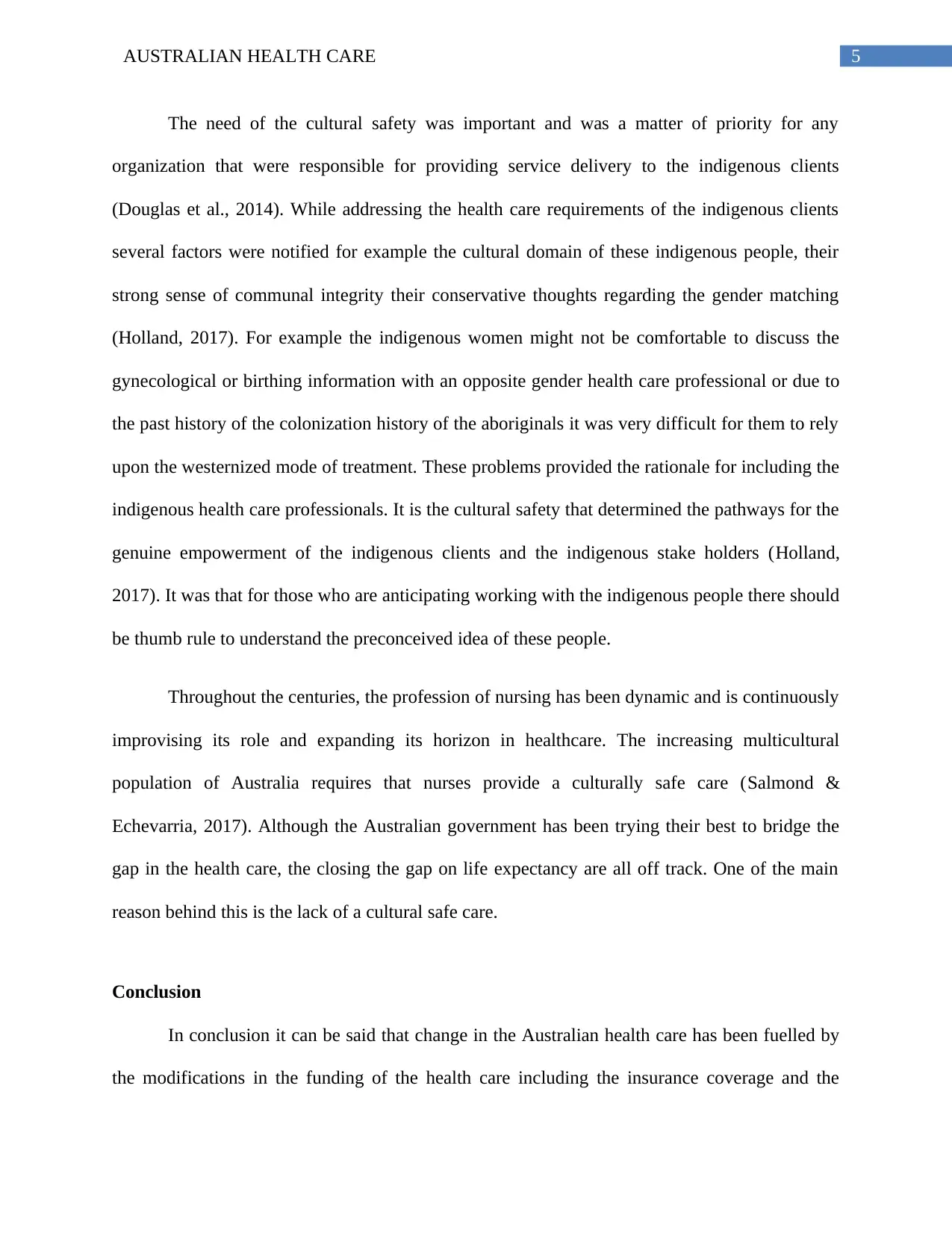
5AUSTRALIAN HEALTH CARE
The need of the cultural safety was important and was a matter of priority for any
organization that were responsible for providing service delivery to the indigenous clients
(Douglas et al., 2014). While addressing the health care requirements of the indigenous clients
several factors were notified for example the cultural domain of these indigenous people, their
strong sense of communal integrity their conservative thoughts regarding the gender matching
(Holland, 2017). For example the indigenous women might not be comfortable to discuss the
gynecological or birthing information with an opposite gender health care professional or due to
the past history of the colonization history of the aboriginals it was very difficult for them to rely
upon the westernized mode of treatment. These problems provided the rationale for including the
indigenous health care professionals. It is the cultural safety that determined the pathways for the
genuine empowerment of the indigenous clients and the indigenous stake holders (Holland,
2017). It was that for those who are anticipating working with the indigenous people there should
be thumb rule to understand the preconceived idea of these people.
Throughout the centuries, the profession of nursing has been dynamic and is continuously
improvising its role and expanding its horizon in healthcare. The increasing multicultural
population of Australia requires that nurses provide a culturally safe care (Salmond &
Echevarria, 2017). Although the Australian government has been trying their best to bridge the
gap in the health care, the closing the gap on life expectancy are all off track. One of the main
reason behind this is the lack of a cultural safe care.
Conclusion
In conclusion it can be said that change in the Australian health care has been fuelled by
the modifications in the funding of the health care including the insurance coverage and the
The need of the cultural safety was important and was a matter of priority for any
organization that were responsible for providing service delivery to the indigenous clients
(Douglas et al., 2014). While addressing the health care requirements of the indigenous clients
several factors were notified for example the cultural domain of these indigenous people, their
strong sense of communal integrity their conservative thoughts regarding the gender matching
(Holland, 2017). For example the indigenous women might not be comfortable to discuss the
gynecological or birthing information with an opposite gender health care professional or due to
the past history of the colonization history of the aboriginals it was very difficult for them to rely
upon the westernized mode of treatment. These problems provided the rationale for including the
indigenous health care professionals. It is the cultural safety that determined the pathways for the
genuine empowerment of the indigenous clients and the indigenous stake holders (Holland,
2017). It was that for those who are anticipating working with the indigenous people there should
be thumb rule to understand the preconceived idea of these people.
Throughout the centuries, the profession of nursing has been dynamic and is continuously
improvising its role and expanding its horizon in healthcare. The increasing multicultural
population of Australia requires that nurses provide a culturally safe care (Salmond &
Echevarria, 2017). Although the Australian government has been trying their best to bridge the
gap in the health care, the closing the gap on life expectancy are all off track. One of the main
reason behind this is the lack of a cultural safe care.
Conclusion
In conclusion it can be said that change in the Australian health care has been fuelled by
the modifications in the funding of the health care including the insurance coverage and the
⊘ This is a preview!⊘
Do you want full access?
Subscribe today to unlock all pages.

Trusted by 1+ million students worldwide
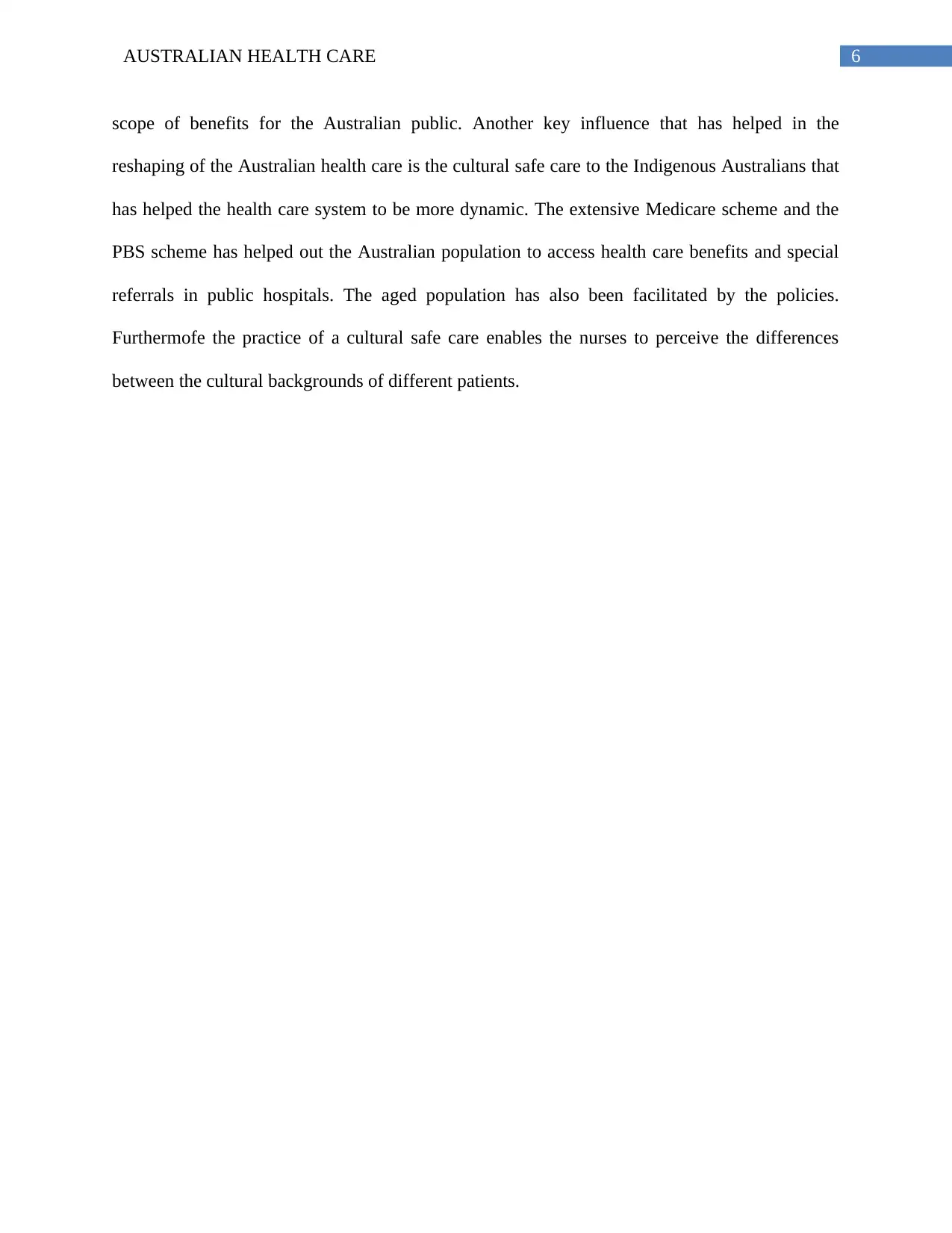
6AUSTRALIAN HEALTH CARE
scope of benefits for the Australian public. Another key influence that has helped in the
reshaping of the Australian health care is the cultural safe care to the Indigenous Australians that
has helped the health care system to be more dynamic. The extensive Medicare scheme and the
PBS scheme has helped out the Australian population to access health care benefits and special
referrals in public hospitals. The aged population has also been facilitated by the policies.
Furthermofe the practice of a cultural safe care enables the nurses to perceive the differences
between the cultural backgrounds of different patients.
scope of benefits for the Australian public. Another key influence that has helped in the
reshaping of the Australian health care is the cultural safe care to the Indigenous Australians that
has helped the health care system to be more dynamic. The extensive Medicare scheme and the
PBS scheme has helped out the Australian population to access health care benefits and special
referrals in public hospitals. The aged population has also been facilitated by the policies.
Furthermofe the practice of a cultural safe care enables the nurses to perceive the differences
between the cultural backgrounds of different patients.
Paraphrase This Document
Need a fresh take? Get an instant paraphrase of this document with our AI Paraphraser
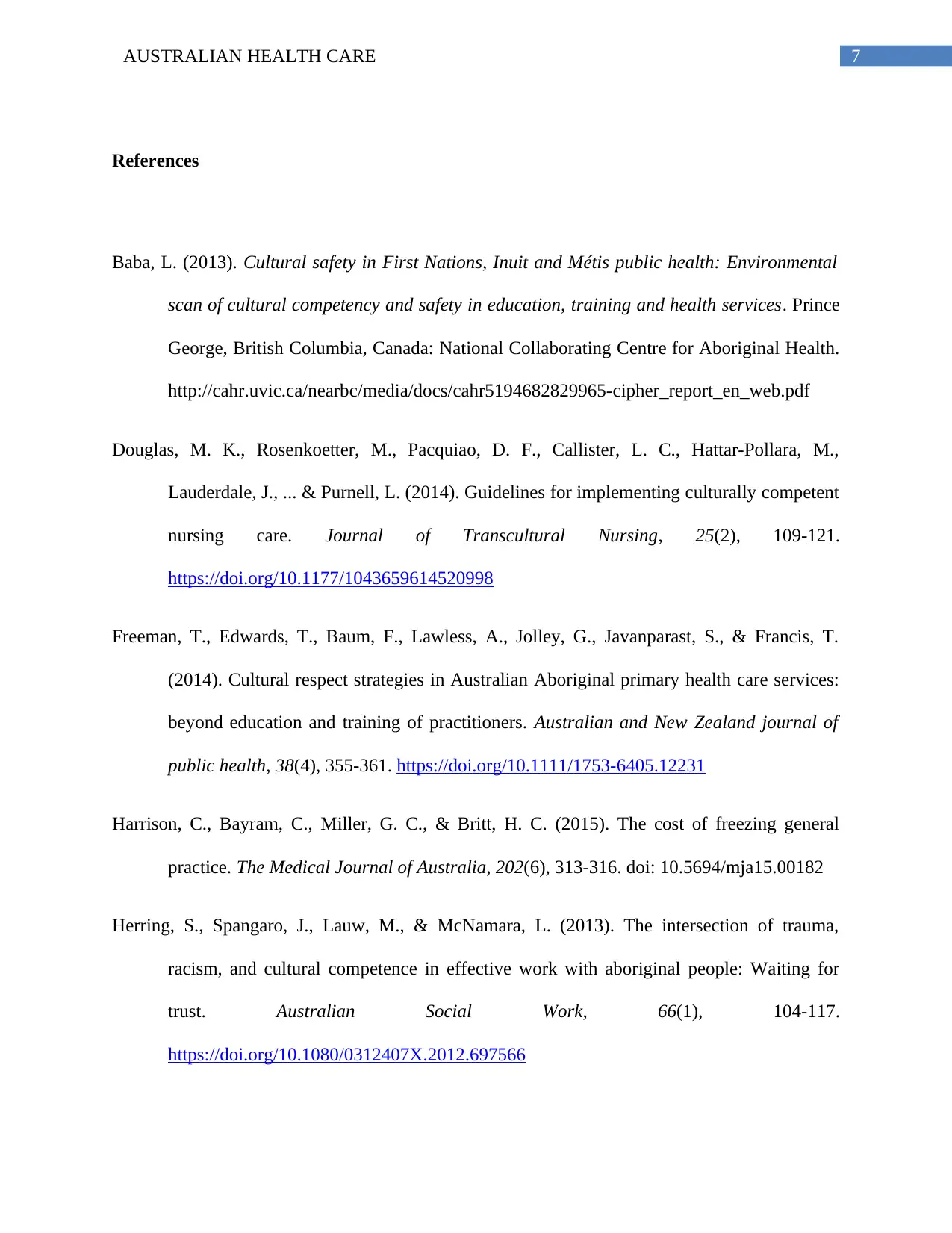
7AUSTRALIAN HEALTH CARE
References
Baba, L. (2013). Cultural safety in First Nations, Inuit and Métis public health: Environmental
scan of cultural competency and safety in education, training and health services. Prince
George, British Columbia, Canada: National Collaborating Centre for Aboriginal Health.
http://cahr.uvic.ca/nearbc/media/docs/cahr5194682829965-cipher_report_en_web.pdf
Douglas, M. K., Rosenkoetter, M., Pacquiao, D. F., Callister, L. C., Hattar-Pollara, M.,
Lauderdale, J., ... & Purnell, L. (2014). Guidelines for implementing culturally competent
nursing care. Journal of Transcultural Nursing, 25(2), 109-121.
https://doi.org/10.1177/1043659614520998
Freeman, T., Edwards, T., Baum, F., Lawless, A., Jolley, G., Javanparast, S., & Francis, T.
(2014). Cultural respect strategies in Australian Aboriginal primary health care services:
beyond education and training of practitioners. Australian and New Zealand journal of
public health, 38(4), 355-361. https://doi.org/10.1111/1753-6405.12231
Harrison, C., Bayram, C., Miller, G. C., & Britt, H. C. (2015). The cost of freezing general
practice. The Medical Journal of Australia, 202(6), 313-316. doi: 10.5694/mja15.00182
Herring, S., Spangaro, J., Lauw, M., & McNamara, L. (2013). The intersection of trauma,
racism, and cultural competence in effective work with aboriginal people: Waiting for
trust. Australian Social Work, 66(1), 104-117.
https://doi.org/10.1080/0312407X.2012.697566
References
Baba, L. (2013). Cultural safety in First Nations, Inuit and Métis public health: Environmental
scan of cultural competency and safety in education, training and health services. Prince
George, British Columbia, Canada: National Collaborating Centre for Aboriginal Health.
http://cahr.uvic.ca/nearbc/media/docs/cahr5194682829965-cipher_report_en_web.pdf
Douglas, M. K., Rosenkoetter, M., Pacquiao, D. F., Callister, L. C., Hattar-Pollara, M.,
Lauderdale, J., ... & Purnell, L. (2014). Guidelines for implementing culturally competent
nursing care. Journal of Transcultural Nursing, 25(2), 109-121.
https://doi.org/10.1177/1043659614520998
Freeman, T., Edwards, T., Baum, F., Lawless, A., Jolley, G., Javanparast, S., & Francis, T.
(2014). Cultural respect strategies in Australian Aboriginal primary health care services:
beyond education and training of practitioners. Australian and New Zealand journal of
public health, 38(4), 355-361. https://doi.org/10.1111/1753-6405.12231
Harrison, C., Bayram, C., Miller, G. C., & Britt, H. C. (2015). The cost of freezing general
practice. The Medical Journal of Australia, 202(6), 313-316. doi: 10.5694/mja15.00182
Herring, S., Spangaro, J., Lauw, M., & McNamara, L. (2013). The intersection of trauma,
racism, and cultural competence in effective work with aboriginal people: Waiting for
trust. Australian Social Work, 66(1), 104-117.
https://doi.org/10.1080/0312407X.2012.697566
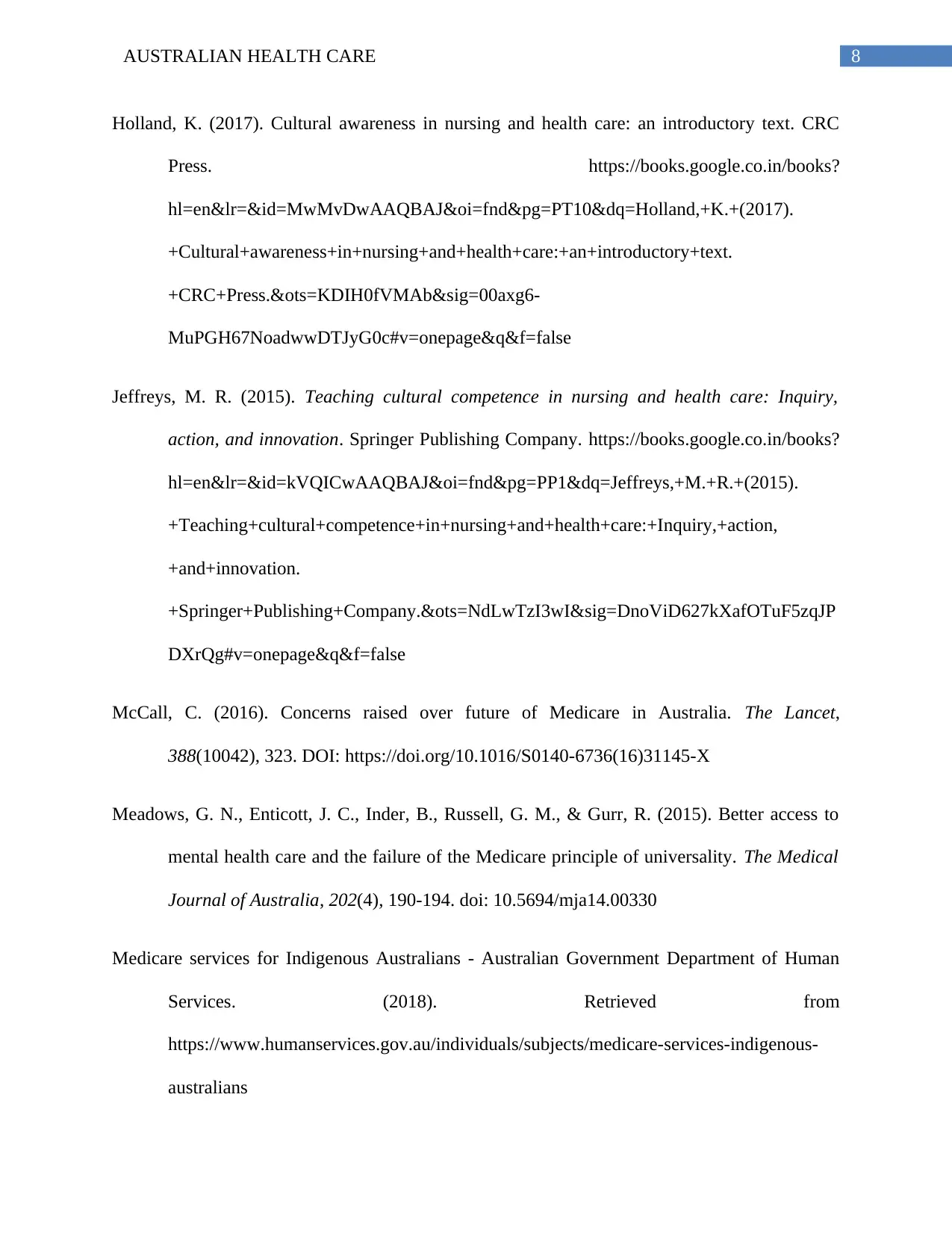
8AUSTRALIAN HEALTH CARE
Holland, K. (2017). Cultural awareness in nursing and health care: an introductory text. CRC
Press. https://books.google.co.in/books?
hl=en&lr=&id=MwMvDwAAQBAJ&oi=fnd&pg=PT10&dq=Holland,+K.+(2017).
+Cultural+awareness+in+nursing+and+health+care:+an+introductory+text.
+CRC+Press.&ots=KDIH0fVMAb&sig=00axg6-
MuPGH67NoadwwDTJyG0c#v=onepage&q&f=false
Jeffreys, M. R. (2015). Teaching cultural competence in nursing and health care: Inquiry,
action, and innovation. Springer Publishing Company. https://books.google.co.in/books?
hl=en&lr=&id=kVQICwAAQBAJ&oi=fnd&pg=PP1&dq=Jeffreys,+M.+R.+(2015).
+Teaching+cultural+competence+in+nursing+and+health+care:+Inquiry,+action,
+and+innovation.
+Springer+Publishing+Company.&ots=NdLwTzI3wI&sig=DnoViD627kXafOTuF5zqJP
DXrQg#v=onepage&q&f=false
McCall, C. (2016). Concerns raised over future of Medicare in Australia. The Lancet,
388(10042), 323. DOI: https://doi.org/10.1016/S0140-6736(16)31145-X
Meadows, G. N., Enticott, J. C., Inder, B., Russell, G. M., & Gurr, R. (2015). Better access to
mental health care and the failure of the Medicare principle of universality. The Medical
Journal of Australia, 202(4), 190-194. doi: 10.5694/mja14.00330
Medicare services for Indigenous Australians - Australian Government Department of Human
Services. (2018). Retrieved from
https://www.humanservices.gov.au/individuals/subjects/medicare-services-indigenous-
australians
Holland, K. (2017). Cultural awareness in nursing and health care: an introductory text. CRC
Press. https://books.google.co.in/books?
hl=en&lr=&id=MwMvDwAAQBAJ&oi=fnd&pg=PT10&dq=Holland,+K.+(2017).
+Cultural+awareness+in+nursing+and+health+care:+an+introductory+text.
+CRC+Press.&ots=KDIH0fVMAb&sig=00axg6-
MuPGH67NoadwwDTJyG0c#v=onepage&q&f=false
Jeffreys, M. R. (2015). Teaching cultural competence in nursing and health care: Inquiry,
action, and innovation. Springer Publishing Company. https://books.google.co.in/books?
hl=en&lr=&id=kVQICwAAQBAJ&oi=fnd&pg=PP1&dq=Jeffreys,+M.+R.+(2015).
+Teaching+cultural+competence+in+nursing+and+health+care:+Inquiry,+action,
+and+innovation.
+Springer+Publishing+Company.&ots=NdLwTzI3wI&sig=DnoViD627kXafOTuF5zqJP
DXrQg#v=onepage&q&f=false
McCall, C. (2016). Concerns raised over future of Medicare in Australia. The Lancet,
388(10042), 323. DOI: https://doi.org/10.1016/S0140-6736(16)31145-X
Meadows, G. N., Enticott, J. C., Inder, B., Russell, G. M., & Gurr, R. (2015). Better access to
mental health care and the failure of the Medicare principle of universality. The Medical
Journal of Australia, 202(4), 190-194. doi: 10.5694/mja14.00330
Medicare services for Indigenous Australians - Australian Government Department of Human
Services. (2018). Retrieved from
https://www.humanservices.gov.au/individuals/subjects/medicare-services-indigenous-
australians
⊘ This is a preview!⊘
Do you want full access?
Subscribe today to unlock all pages.

Trusted by 1+ million students worldwide
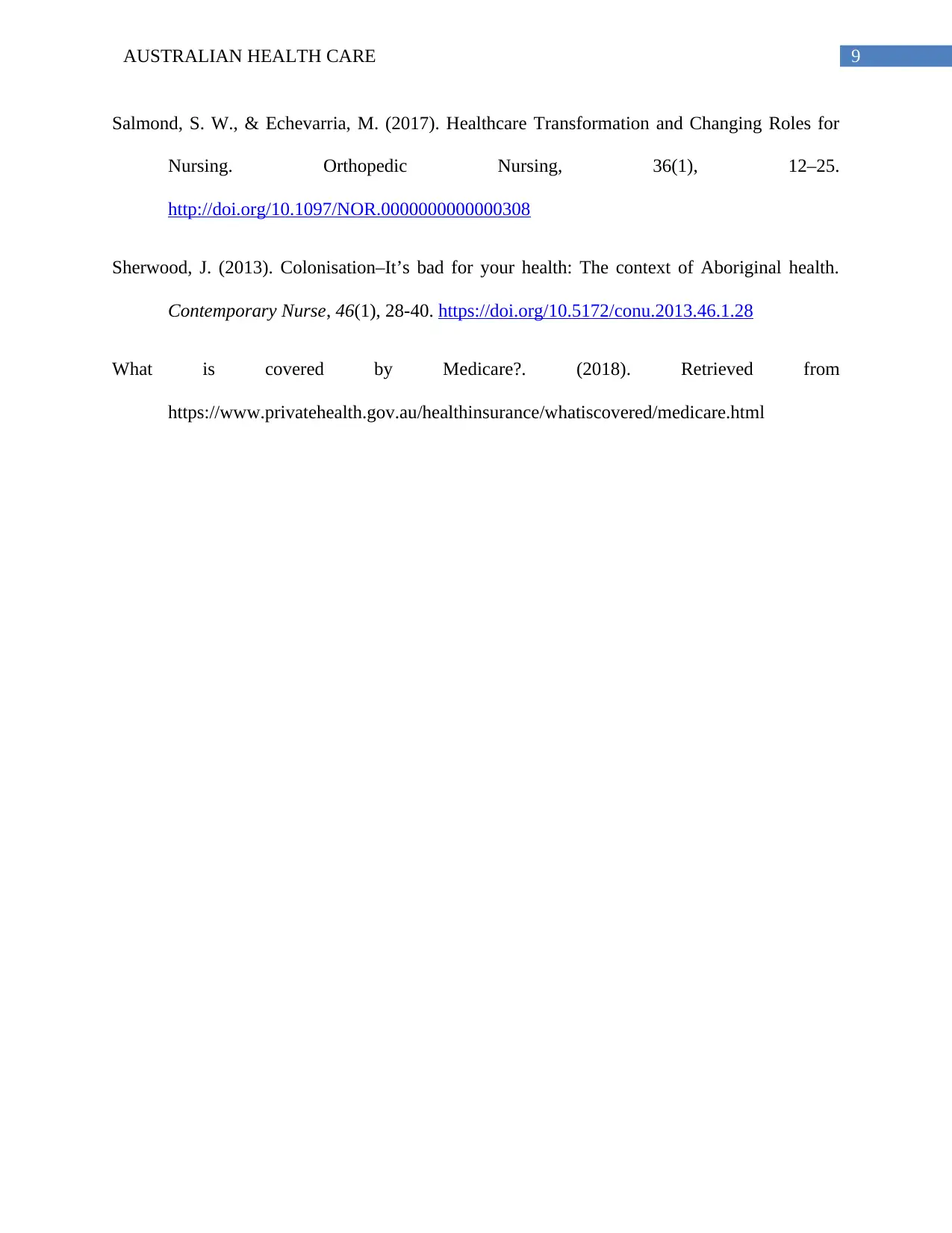
9AUSTRALIAN HEALTH CARE
Salmond, S. W., & Echevarria, M. (2017). Healthcare Transformation and Changing Roles for
Nursing. Orthopedic Nursing, 36(1), 12–25.
http://doi.org/10.1097/NOR.0000000000000308
Sherwood, J. (2013). Colonisation–It’s bad for your health: The context of Aboriginal health.
Contemporary Nurse, 46(1), 28-40. https://doi.org/10.5172/conu.2013.46.1.28
What is covered by Medicare?. (2018). Retrieved from
https://www.privatehealth.gov.au/healthinsurance/whatiscovered/medicare.html
Salmond, S. W., & Echevarria, M. (2017). Healthcare Transformation and Changing Roles for
Nursing. Orthopedic Nursing, 36(1), 12–25.
http://doi.org/10.1097/NOR.0000000000000308
Sherwood, J. (2013). Colonisation–It’s bad for your health: The context of Aboriginal health.
Contemporary Nurse, 46(1), 28-40. https://doi.org/10.5172/conu.2013.46.1.28
What is covered by Medicare?. (2018). Retrieved from
https://www.privatehealth.gov.au/healthinsurance/whatiscovered/medicare.html
1 out of 10
Related Documents
Your All-in-One AI-Powered Toolkit for Academic Success.
+13062052269
info@desklib.com
Available 24*7 on WhatsApp / Email
![[object Object]](/_next/static/media/star-bottom.7253800d.svg)
Unlock your academic potential
Copyright © 2020–2025 A2Z Services. All Rights Reserved. Developed and managed by ZUCOL.





